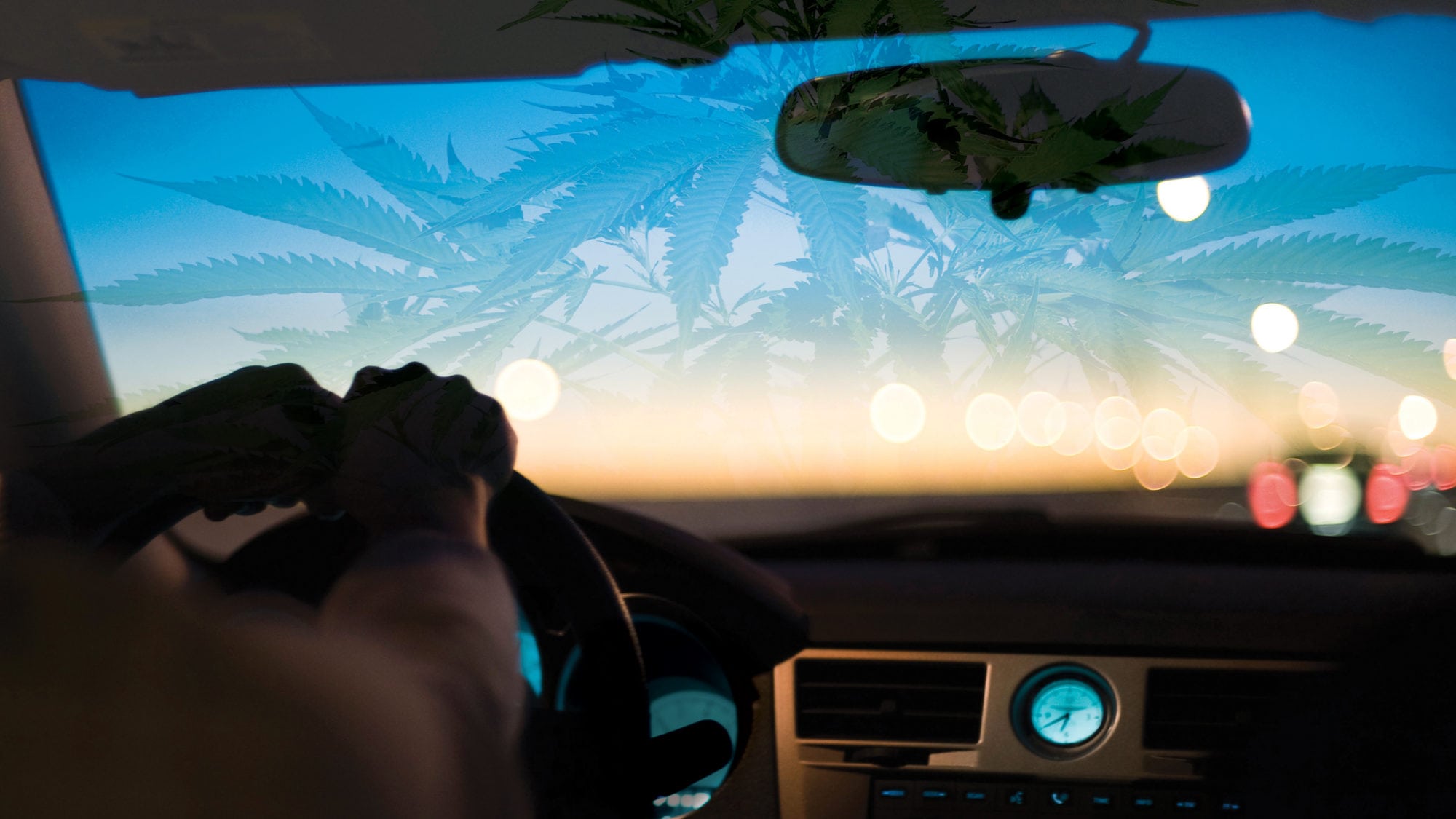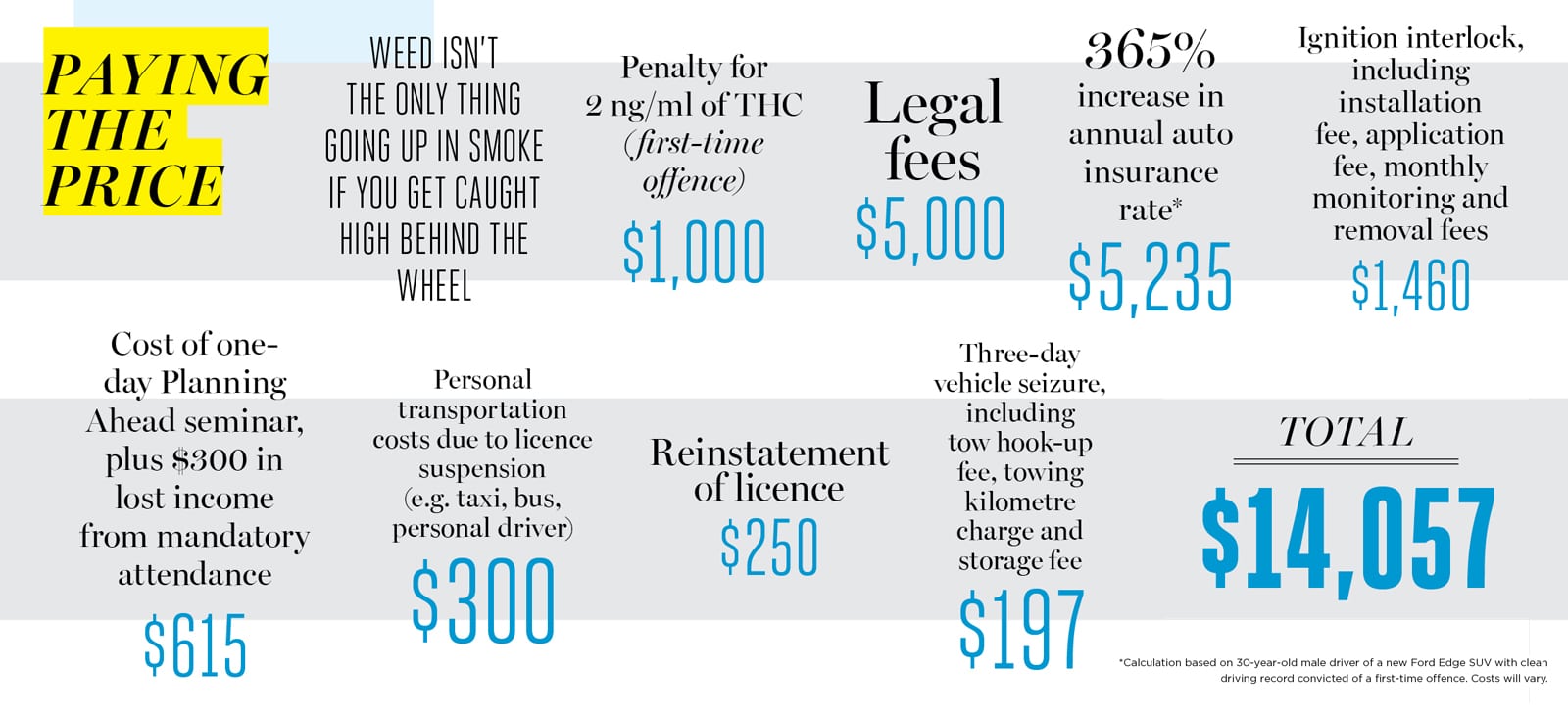Cannabis (a.k.a. marijuana) is now legally accessible across Canada. Here’s what you need to know about cannabis and driving in Alberta.
Can I drive under the influence of cannabis? Cannabis and other drugs have an impact on your ability to safely operate a vehicle, and drug-impaired driving is already a crime. Unlike alcohol— for which there’s a simple breath test to determine intoxication—proving impairment by cannabis requires an expert to make observations about a driver’s behaviour. Bill C-46 attempts to fix this problem by specifying blood-concentration limits for tetrahydrocannabinol (THC), the main active ingredient in cannabis. If a driver is found with more than the legal maximum amount of THC in their body within two hours of driving, they can be charged with a criminal offence.
Not every driver caught driving under the influence of cannabis will be criminally charged. In late 2017, amendments to Alberta’s Traffic Safety Act created a number of new provincial offences for drivers caught with alcohol or drugs in their blood.
Drivers who are hit with a provincial penalty for impaired driving will face stiff consequences: a 90-day licence suspension and mandatory participation in a remedial course. In addition to such administrative penalties, Alberta police may also consider charges under the Criminal Code, including imprisonment for repeat offenders and more serious offences.
DRIVING HIGH IS A D.U.I.
Get a reality check about the risks of getting behind the wheel while under the influence of cannabis
Scott Wilson, senior policy analyst at AMA, is optimistic about the impact of the new penalties. “The legislative framework in Alberta is pretty robust,” he says. “But there’s a need for continued research about the link between THC and impairment.” Wilson also cautions that the job of preventing cannabis-impaired driving won’t be complete until drivers know about the risks. To that end, CAA National, as well as federal and provincial governments, have all begun public-education campaigns about the risks of mixing cannabis and driving.
UNDER THE INFLUENCE
There’s broad scientific agreement that cannabis intoxication can change driver behaviour. What’s less clear, however, is the amount of the drug that’s needed to impair driving, and the extent to which it increases the risk of a crash. Each person is affected by cannabis differently; there’s no agreed-upon level of THC that’s “safe” for everyone. Therefore it’s generally best if drivers take a zero-tolerance approach.
Unlike alcohol, which has a profound effect on physical coordination even at relatively low levels, cannabis’s most pronounced effects are on the way a person thinks—and how a driver might react to unexpected occurrences on the road. “Things like memory and concentration are affected. Attention, decision-making, and higher-order planning and execution of complex tasks are also affected,” says Douglas Beirness, senior research and policy analyst with the Canadian Centre on Substance Abuse. “In a driving situation, that’s not going to work real well for you.”
 Some studies, however, have looked at the physical dimension of cannabis impairment; among other things, they’ve shown that drivers under the influence of the drug are more prone to drifting across traffic lanes. A 2012 study by researchers at Dalhousie University in Halifax found that recent use of cannabis nearly doubles a driver’s risk of being seriously injured or killed in a crash.
Some studies, however, have looked at the physical dimension of cannabis impairment; among other things, they’ve shown that drivers under the influence of the drug are more prone to drifting across traffic lanes. A 2012 study by researchers at Dalhousie University in Halifax found that recent use of cannabis nearly doubles a driver’s risk of being seriously injured or killed in a crash.
Research conducted in Washington state, which made recreational cannabis legal in 2012, has likewise been illuminating: In 2014, it was estimated that the number of drivers with THC in their bloodstream who were involved in fatal accidents had nearly doubled over the previous year, suggesting that more people were driving (and dying) with cannabis in their bodies subsequent to the drug’s legalization.
ENFORCEMENT ON THE ROAD
One of the biggest changes to police powers under Bill C-46 has more to do with alcohol than cannabis. The law gives police officers the ability to undertake mandatory random breath screening—meaning an officer may demand a breath sample from any driver they lawfully stop, even if there’s no reason to suspect the person behind the wheel has consumed alcohol.
For cannabis and other drugs, the bill also authorizes police to use special screening devices to screen drivers at roadside, provided they suspect the driver has recently used drugs. But testing for cannabis isn’t as straightforward as testing for alcohol.
TESTING CHALLENGES
The cannabis test requires a sample of saliva. Typically, an officer will rub an oral swab over a driver’s gums, tongue and inner cheeks. The swab is inserted into a machine, which then analyzes the saliva.
The feds are currently reviewing two testing devices that, when used together, ascertain the presence of a drug in a person’s body. If approved, they’ll be put into use when legalization takes effect on October 17.
Until then, police officers continue to rely on the Standardized Field Sobriety Test—the same battery of physical- and mental-coordination tasks they already use at the roadside to identify impaired drivers. That said, under Bill C-46, drivers who fail a roadside sobriety test must accompany police for further testing. The law makes it easier for police to demand blood samples, and drivers who are suspected of being impaired may also be interviewed by Drug Recognition Experts, (DRE)—police officers who’ve been trained to recognize the signs of intoxication by various narcotics, including cannabis.
NEXT STEPS
One thing to expect, according to AMA’s Wilson, is that there will be an increase in cannabis use, and likely also an increase in individuals driving while impaired. So it’s important that law enforcement agencies train more DREs before cannabis becomes fully legal. “We need to be sure that we can maintain a high level of public safety; building capacity for DREs is one way of doing that,” Wilson says.
The availability of reliable oral-screening devices and the capability to conduct impaired driving–related blood tests within a two-hour timeframe will be equally crucial. AMA also hopes to see researchers continue to study the link between THC and impairment, so that conclusive limits can be established.
MORE TO READ
Life in the fast lane: Road safety risks in Alberta
As all levels of government prepare for legalization, AMA continues to call for comprehensive public education about how cannabis affects driving ability, with specific messages targeted to young people. “As we saw with alcohol, public education will be important in dispelling cannabis myths and reducing impaired driving,” Wilson adds. “We’re committed to working with government and non-government stakeholders to ensure our roads remain safe for all Albertans.”
RISKY BUSINESS
The legalization of cannabis may not immediately impact auto insurance rates, but motorists already face major consequences for driving while impaired—by alcohol, cannabis or any other drug.
“Rates are already affected by factors like serious convictions, traffic convictions and licence suspensions,” says James Setch, vice-president of underwriting for AMA Insurance. “Specific convictions for impaired driving while under the influence of cannabis will likely evolve, but they will be enforced and will impact an individual’s insurance premium.”
Bear in mind, too, that if reckless driving were to increase overall, so would insurance claims—and then insurance rates. It’s in everyone’s best interest to drive safe and sober.
JUST THE FACTS
Historically, it’s been all too easy to get lost in a haze of misinformation about cannabis use. It’s time to set the record straight.
Myth: Driving high is safer than driving drunk.
Fact: Even a small amount of cannabis will impair driving performance, since it affects the cognitive abilities that you need to drive safely—alertness, concentration, reaction time, ability to judge distances, perception, coordination and motor skills. Impairment is impairment, whether it’s due to alcohol or drugs. It’s best to separate driving from cannabis use.
Myth: You drive better when you’re high.
Fact: Tests have shown that drivers who are high are keenly aware they’re impaired, so they develop compensatory strategies such as driving slower or increasing their following distance. But that doesn’t mean they’re driving more safely. In the U.S., where a handful of states have legalized recreational cannabis use, research shows that drug-impaired driving fatalities have actually increased.
Myth: Younger adults are more educated about how cannabis affects driving.
Fact: You’d think so, but according to a recent CAA survey, nearly one in three Canadians aged 18 to 34 believe they can drive better when high.
MORE TO READ
Installing a dash cam can offer peace of mind on the road
Myth: There’s no roadside drug test yet.
Fact: Two saliva-screening devices have been submitted for approval. If approved, they wouldn’t come into use until October, but police can still conduct a Standard Field Sobriety Test. This test detects drug impairment and probable cause for arrest. If you’re arrested, a trained Drug Recognition Expert will perform further testing at the police station.
Myth: Cannabis affects everyone the same way.
Fact: Cannabis’s active ingredient, THC, affects everyone differently and in different ways. One person may become impaired after one or two puffs, while another could be unaffected after consuming the same amount. There’s no benchmark amount that’s safe for all. If you’re using cannabis, plan ahead and arrange for a safe drive home.
Myth: The government hasn’t yet set penalties for cannabis impairment.
Fact: Federal and provincial penalties are enshrined in law. Drug-impaired drivers charged under Alberta laws can expect to have their licence suspended and vehicle seized, and are required to attend a remedial education course. Drivers can also be charged under the Criminal Code of Canada, which means a hefty fine and possible imprisonment, depending on your record of prior convictions and the amount of THC and alcohol in your blood.
Myth: There are exemptions for people who use prescription cannabis.
Fact: Even if you use cannabis for medical purposes, you can’t legally drive while drug-impaired.

